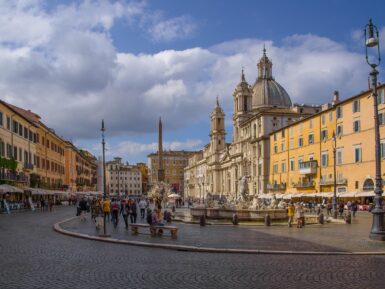Table of Contents
1. History

The Spanish steps are one of Rome’s most famous landmarks built between 1723 and 1725 to create a grand connection between Piazza Di Spagna (at the bottom) and Trinita Dei Monti Church (at the top). The project was designed by Francesco de Sanctis, an Italian architect. The project was designed by Francesco de Sanctis, an Italian architect and funded by French diplomat Etienne Gueffier, who wanted to improve access to the church.
At the time, the area was an important gathering point, but the steep hill made it difficult for people to reach the church. The elegant 135 steps staircase solved this problem while adding a beautiful architecture element to the city.
Interestingly, the name Spanish steps does not come from their builders but from Spanish embassy, which has been in Piazza di Spagna since 17th century. Over the centuries, the Spanish steps have been a popular meeting place for both locals and tourist. They have featured in classic films like “Roman Holidays” (1953) further cementing their place in pop culture.
While exploring Rome’s landmarks, don’t miss the Pantheon, another historic masterpiece just a short walk from here
However, to protect this historic site, sitting on steps is now prohibited and visitors must admire them while standing or walking.
2. Architecture and Engineering

The Spanish steps are not just steps they are beautifully designed Baroque-style landmarks made from Travertine stone, a material used in many Roman monuments. The 135 steps gently curve down from Trinita De Monti Church to Piazza De Spagna, making them a stunning sight.
What makes them special?
Wide and Flowing design – Unlike regular stairs, these have curves and terraces making them feel open and inviting.
Three Levels – The staircase is divided into 3 sections, symbolizing the Holy Trinity offering different city views as you climb.
Perfect Symmetry – The steps are designed to balance curves, straight lines and terrace for a natural flow.
Trinita De Monti Church – At the top, the 16th century church with twin towers is a great photo spot with panoramic views of Rome.
Step back in time and explore the legendary Colosseum, Palatine Hill, and Roman Forum—Rome’s iconic trio of ancient wonders
3. Photography Tips
1. Arrive early for Empty steps – Visit before 08:00 Am to avoid crowds and capture the steps in soft morning light.
2. Shoot from Piazza di Spagna, stand near Fontana Della Barcaccia to capture the full staircase with Trinita Dei Monti Church in the background.
3. Use the side pathways, move to the left or right for a unique angle that highlights the steps curves and avoids crowded shots.
4. Capture the view from top, take a shot from Trinita Dei Monti Church looking down Piazza di Spagna and Via Dei Condotti.

5. Include foreground elements, frame your shot with pink azaleas (in spring) or the fountain to add depth and colour.
6. Try a night shot, the steps are beautifully lit at night making for a stunning long-exposure photo
After capturing your perfect shot, take a short walk to Trevi Fountain, one of Rome’s most breathtaking spot where you can toss a coin and make a wish. Then, continue Campo de’ Fiori, a lively square famous for its market and nightlife, street performers, and authentic Roman charm. Don’t miss Piazza Navona – the fountain square.
4. Best Time to Visit

The best time to visit the Spanish steps is early morning, ideally before 08:00 AM when the crowds are minimal, and the soft morning light makes for stunning photos. If you prefer a livelier atmosphere, late afternoon during golden hour is another great option as the warm sunlight enhances the beauty of the step and the surrounding architecture, though it tends to be busier.
Spring (April-May) is particularly special as the steps are decorated with vibrant pink azaleas making them even more picturesque. However, it’s best time to avoid midday as the sun can be harsh and the steps become packed with tourists. Similarly, July and August can be uncomfortable due to high temperatures and heavy crowds, making early mornings or evenings the most enjoyable time to visit.
Check out the 25 Best Things to Do in Italy to make the most of your journey
5. FAQ’s
What is so special about the Spanish Steps?
The Spanish steps are famous for their elegant Baroque design, 135- step grand staircase, and connection between Piazza Di Spagna and Trinitia Dei Monti Church. They are a top photography spot and a historic gathering place in Rome.
Why can’t you sit on the Spanish Steps in Rome anymore?
Sitting on the Spanish steps is banned to protect the historic travertine stone from damage and overcrowding. You can face a fine up to €400 for that.
How much does it cost to go to the Spanish Steps?
Visiting the Spanish steps is completely free of cost.
Are the Spanish Steps hard to climb?
The 135 steps are not too steep and are manageable for most visitors. However, those with mobility issues may find it challenging and there are no handrails.
How far apart are the Spanish Steps and the Trevi Fountain?
The distance between Spanish Steps and Trevi Fountain is 1km.





Leave a reply